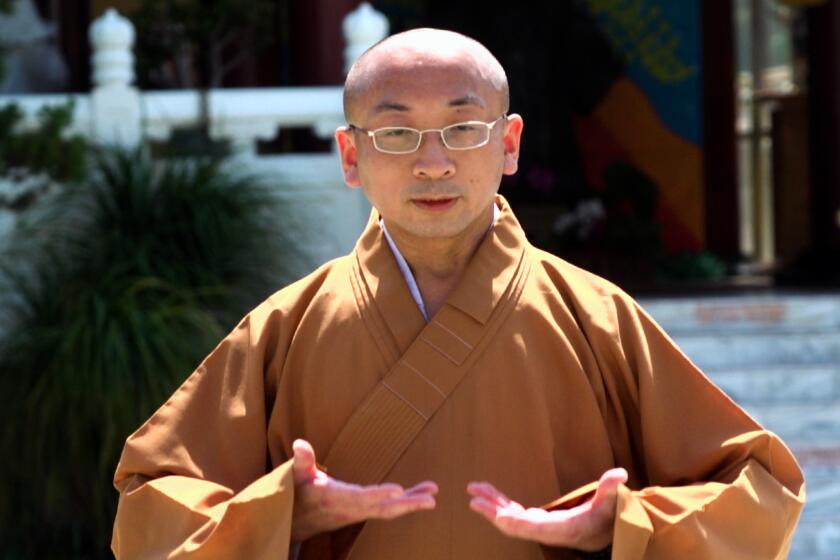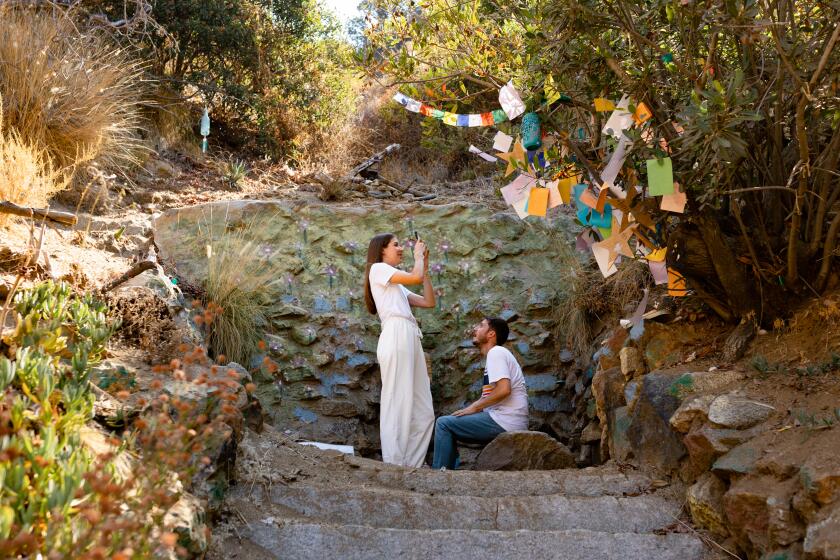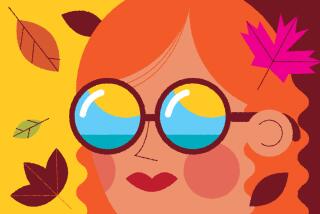
- Share via
On a recent Saturday night, the scene was serene inside Tac-tile Mountain, a small, carefully curated shop in Pasadena. Meditation cushions were laid out on the concrete floor. A sea of white candles was flickering in the window. And then the restaurant next door started blasting “Umbrella” by Rihanna.
The six of us who had gathered inside laughed nervously. We were already excited and a little hesitant. After all, we were there to contemplate our own deaths.
Tac-tile Mountain was hosting “Death Reflections,” a two-hour, $55 workshop led by Marifel Catalig, a trained death doula and breathwork instructor. It had been advertised on Instagram as “a breath guided meditation intended to contemplate death in many forms.” The description ended there, so no one knew exactly what to expect.
Going into the workshop, I hoped that spending an hour meditating on my inevitable demise would ease my fear of dying. What I didn’t anticipate is that I would walk out feeling profoundly grateful for all the ordinary, messy, glittering life I’ve been blessed to live so far.
Meditation is not just about sitting still. Monks from Hacienda Heights’ Hsi Lai Temple show us different ways to maintain a meditative state while carrying on everyday activities.
This overwhelming feeling of gratitude is not unusual after a prolonged death exercise, said Ines Testoni, a social psychologist who directs a course on death studies and end of life at the University of Padova in Italy.
“What I have been seeing for 15 years now is that knowing one has to die allows one to value life, and feel more grateful for what life allows us to do and enjoy,” she said.
Catalig, 40, greeted us at the door wearing a white blouse and wide-legged jeans, then asked us to find our seats. After lighting the candles that were placed at the head of each of our cushions, we began with a gentle movement to release the tension of the day, then focused on our senses — paying close attention to what we could see, hear, taste, feel and smell.
Death meditations are wildly variable. In the Buddhist tradition the practice of maraṇasati, or mindfulness of death, is designed to remind practitioners that death might come as soon as the next morning, the next meal or even the next breath, and encourage them to act accordingly. Another Buddhist practice focuses on a detailed visualization of the body’s eventual decay to help relinquish attachment to the material world.
Catalig once attended a death meditation at which participants were wrapped in a white sheet to mimic the shroud they might wear after they die. Another time she led a living funeral workshop where people were asked to write a eulogy for themselves that she read out loud to the group.
The meditation I attended was simpler. The focus was primarily on the type of life review many people undertake before they die.
Feeling sad or hopeless ? These 12 beautiful places in Los Angeles will lift your spirits.
Accompanied by a playlist of instrumental music that was more evocative than annoying, Catalig asked us to imagine our earliest memories and consider where we were, who was there, what we felt like, what it smelled like and what sounds we heard. We did the same for our early childhood, pre-adolescence, adolescence, early adulthood and on.
As she spoke, memories of the many lives I’ve lived flashed through my mind. Most of them were mundane, but they filled me with a sense of tenderness. There I was playing with a Fisher-Price barn on a green carpet, walking to school in new saddle shoes, riding bikes on the sidewalk with my sister. I saw sleepovers and middle school dances, late summer nights wandering around my hometown, blissfully bored and aimless.
Nobody has lived your life but you. All of your experiences, everything that got you here, that belongs to you.
— Marifel Catalig, breathwork instructor
I saw scenes from my adult life before kids, my life as a new parent, my life with small children and, finally, my life now — my husband, my teenage sons, my colleagues, my friends. All the different and distinct lives I’ve lived.
“Nobody has lived your life but you,” Catalig said. “All of your experiences, everything that got you here, that belongs to you.”
Then the music shifted and she asked us to imagine that we were nearing death. Our eyesight was fading, our hearing becoming more muffled. Food didn’t taste as good as it once did and we were eating less. In my mind I felt myself receding from the immediacy of life — a fog of gray between me and the world. As my experience of the world became more muted, I felt less afraid of leaving it.
Then Catalig had us imagine our last days. Who would visit us? What would they say? And then we pictured our last breath. “What do you want to breathe in?” she asked. “And what do you want to breathe out?”
We imagined hovering above our lifeless bodies, what they would look like, and who would tend to them. For a brief moment, we imagined what might be next.
In a society that rarely encourages reflections on death and dying, many of us respond to our innate fear of death with denial, Testoni said. Carving out time to visualize and imagine our own passing can help us face that fear in a productive way.
“Reflection makes us realize that we are afraid of something we do not know,” she said. “Knowing that we don’t know but we can know a lot is definitely reassuring.”
When the meditation was over, Catalig invited us to share about the experience.
One participant said the meditation helped her reframe the times in her life when she thought she was a bad person. Instead, she saw herself with more compassion. Another participant said she felt that her higher self had been with her all along, and was still with her. This brought her great comfort.
As for me, I walked out of the store in a state of elation. I was less afraid of dying, but mostly I felt so thrilled to be alive.
If you’re curious to try one of Catalig’s death meditations, you can find future offerings on her Instagram page, or contact her through her website breathtodeath.com.
- Share via
Watch L.A. Times Today at 7 p.m. on Spectrum News 1 on Channel 1 or live stream on the Spectrum News App. Palos Verdes Peninsula and Orange County viewers can watch on Cox Systems on channel 99.
More to Read
Sign up for The Wild
We’ll help you find the best places to hike, bike and run, as well as the perfect silent spots for meditation and yoga.
You may occasionally receive promotional content from the Los Angeles Times.














